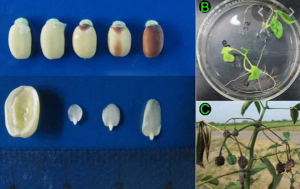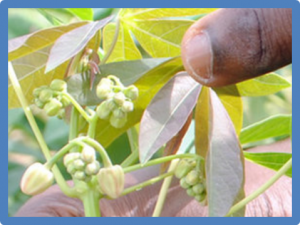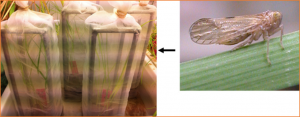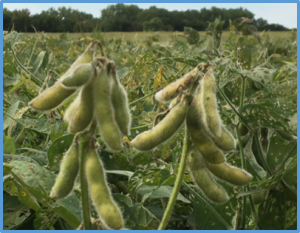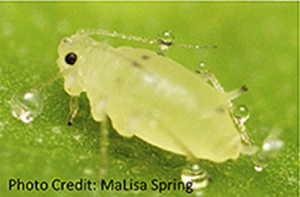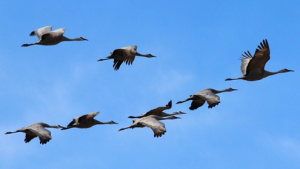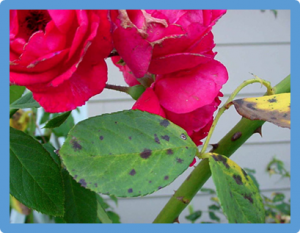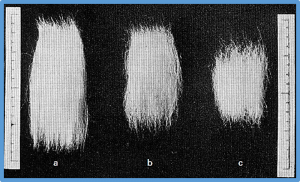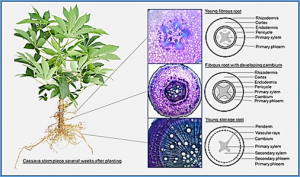Embryo rescue (ER) in cassava breeding has several relevant applications, from the recovery of broad crosses to the recovery of seeds from the standard pollination program. Cassava fruit setting may drop from 100%, during the 1st week after pollination, to less than 40% during the 2nd week after pollination due to the abscission of fruits depending on genotypes. Therefore, the availability of an ER protocol for early stages of embryo development
In Asia, cassava (Manihot esculenta) is cultivated by more than 8 million farmers, driving the rural economy of many countries. The International Center for Tropical Agriculture (CIAT), in partnership with national agricultural research institutes (NARIs), instigated breeding and agronomic research in Asia, 1983. The breeding program has successfully released high-yielding cultivars resulting in an average yield increase from 13.0 t ha-1 in 1996 to 21.3 t ha-1 in 2016, with significant economic benefits
Strategies are still employed to reduce insect damage in crop production, including conventional breeding with wild germplasm resources and transgenic technology with foreign genes' insertion. Cultivated and Bt-transgenic rice (Oryza sativa) and two ecotypes of wild rice (O. rufipogon) were treated by a 72 h feeding of brown plant hopper (Nilaparvata lugens). Under the feeding of N. lugens, compared with the cultivated rice (568 and 4)
Soybean is grown worldwide for oil and protein source as food, feed and industrial raw material for biofuel. Steady increase in soybean production in the past century mainly attributes to genetic mediation including hybridization, mutagenesis and transgenesis. However, genetic resource limitation and intricate social issues in use of transgenic technology impede soybean improvement to meet rapid increases in global demand for soybean products.
Aphids are emerging as model organisms for both basic and applied research. Of the 5,000 estimated species, only three aphids have published whole genome sequences: the pea aphid Acyrthosiphon pisum, the Russian wheat aphid, Diuraphis noxia, and the green peach aphid, Myzus persicae. We present the whole genome sequence of a fourth aphid, the soybean aphid (Aphis glycines), which is an extreme specialist and an important invasive pest of soybean (Glycine max).
Massive wildlife losses over the past 50 y have brought new urgency to identifying both the drivers of population decline and potential solutions. We provide large-scale evidence that air pollution, specifically ozone, is associated with declines in bird abundance in the United States. We show that an air pollution regulation limiting ozone precursors emissions has delivered substantial benefits to bird conservation.
The widespread rose black spot disease (BSD) caused by the hemibiotrophic fungus Diplocarpon rosae Wolf. is efficiently controlled with fungicides. However, in the actual context of reducing agrochemical use, the demand for rose bushes with higher levels of resistance has increased. Qualitative resistance conferred by major genes (Rdr genes) has been widely studied but quantitative resistance to BSD requires further investigation.
Good fibre quality and high yield are important production goals in cotton (Gossypium hirsutum L.), which is a leading natural fibre crop worldwide. However, a greater understanding of the genetic variants underlying fibre quality- and yield-related traits is still required. In this study, a large-scale population including 588 F7 recombinant inbred lines, derived from an intraspecific cross between the upland cotton cv.
Herbivory is fundamental to the regulation of both global food webs and the extent of agricultural crop losses. Induced plant responses to herbivores promote resistance and often involve the perception of specific herbivore-associated molecular patterns (HAMPs); however, precisely defined receptors and elicitors associated with herbivore recognition remain elusive. Here, we show that a receptor confers signaling and defense outputs in response to a defined HAMP common in caterpillar oral secretions (OS)
Cassava (Manihot esculenta Crantz) is one of the important staple foods in Sub-Saharan Africa. It produces starchy storage roots that provide food and income for several hundred million people, mainly in tropical agriculture zones. Increasing cassava storage root and starch yield is one of the major breeding targets with respect to securing the future food supply for the growing population of Sub-Saharan Africa.


 Curently online :
Curently online :
 Total visitors :
Total visitors :
